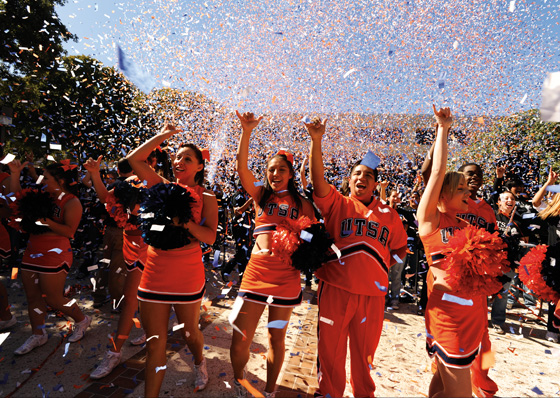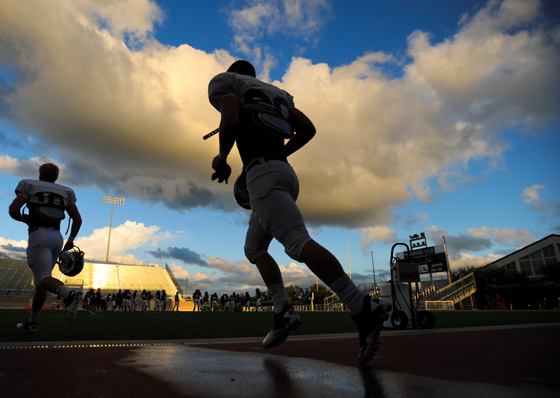
It was a sticky July morning
in front of the Convocation Center on UTSA's Main Campus when head football Coach Larry
Coker suddenly morphed into the Roadrunners' head cheerleader. "Are we ready?" Coker demanded
loudly, like a general before the battle. "Are we ready for football?
"Are we ready?" Coker demanded
loudly, like a general before the battle. "Are we ready for football? "BIRDS UP!"
"BIRDS UP!" The
30 or 40 people gathered around—administrators, faculty, students and staff about to depart
for a tour of football facilities at the Alamodome—obediently extended their arms and flashed
the Roadrunners' hand sign.
The
30 or 40 people gathered around—administrators, faculty, students and staff about to depart
for a tour of football facilities at the Alamodome—obediently extended their arms and flashed
the Roadrunners' hand sign. "Now here's the hard part," Coker teased. "I yell U-T and you yell
S-A. Ready?"
"Now here's the hard part," Coker teased. "I yell U-T and you yell
S-A. Ready?" U-T! S-A! U-T! S-A! U-T! S-A!
U-T! S-A! U-T! S-A! U-T! S-A! The raucous cheer echoed through the Sombrilla,
bounced off the Alamo and wrapped itself around the city of San Antonio.
The raucous cheer echoed through the Sombrilla,
bounced off the Alamo and wrapped itself around the city of San Antonio. Football. It's here.
Football. It's here.

Photo above by Mark McClendon...

Photos by Mark Sobhani...
Football and college life are as interconnected as blood and bone in the American mind. College memories, for many, revolve as much or more around gridiron battles on idyllic autumn afternoons as they do on chemistry labs and English 101.
But football was never inevitable at UTSA, despite the university's being located in a football-loving region of a footballcrazy state. As one administrator said, UTSA was created in 1969 to be an inexpensive alternative for students who wanted a good education but couldn't afford or qualify for other Texas schools. The keep-costs-down, no-frills approach meant the university had to remain a commuter campus with no dorms and few student activities, especially expensive ones like football.
In 1999, UTSA got a new president, Ricardo Romo, and a new athletics director, Lynn Hickey. At the time, neither thought football was feasible.
"Football was still the 'F' word back then," said Brad Parrott, senior associate director of athletics.
But after a year or so, Parrott added, attitudes began to change. Words and phrases such as "Tier One," "research intensive" and "school of first choice" were heard around campus. More and more, administrators and community leaders began to feel that moving UTSA forward would require a more traditional college experience. And that, among other things, meant football.
"After being here a while," Hickey said, "and understanding the needs not only of this campus but of this community and all of South Texas, for us not to go forward would have been the wrong thing."
Quietly, Hickey and Parrott began laying the groundwork for Roadrunners football. They traveled the state visiting other programs as well as athletic conference officials, learning what it would take to field a team. And, to be in Title IX, or gender equality, compliance should football become a reality, the school added women's golf in 2004 and women's soccer in 2006.
The push for San Antonio football picked up steam in the aftermath of Hurricane Katrina in 2005. Because of damage to the Superdome, the NFL's New Orleans Saints set up practice facilities and offices in San Antonio and played some of their home games in the Alamodome.
Behind the scenes, city officials and community leaders lobbied hard to get the Saints to relocate permanently to San Antonio. When those efforts fell through, attention shifted hard to UTSA.
Why couldn't UTSA be San Antonio's team?
Hickey also set up an athletics advisory board of alumni and business leaders, and football was a constant topic.
"We talked for a long time about the long-term goal of football, what was the right time," said Jim Mickey '78, a member of the committee and UTSA's associate vice president for alumni programs and marketing. "The timing had to be right."
Hickey agreed. Crucially, so did Romo.
Even though he's "among the most avid fans of college football," Romo said, "I wanted to make certain that we added a football program at UTSA only when the time was right and we could pay for it. My priorities have always been focused on building a first-class research university that provides students access to a complete university experience."
Romo, said Hickey, "did an outstanding job kind of holding us back until all the pieces were in place."
The concept of UTSA football got a boost with the release of a feasibility study in November 2006. The report by Carr Sports Associates in Gainesville, Fla., outlined the steps UTSA needed to take to implement football. High on the list was fundraising.
In 2007, the idea of football picked up steam. In November, at the dedication ceremony of the Biotechnology, Sciences and Engineering Building, Romo unveiled UTSA's strategic plan, "A Shared Vision: UTSA 2016." Meant to propel the university toward national research university status, it was one of the academic pieces Romo wanted to have in place before football was added.
Just two months earlier, UTSA students had overwhelmingly approved a referendum supporting the expansion of the athletics program and doubling the athletics fee. The vote was key for Romo. "I decided it was the time to move forward," he recalled.
A little more than a year later, in December 2008, the University of Texas System Board of Regents gave the go-ahead. The plan not only approved football, but also called for the building of an $84 million athletics complex, dubbed Park West, for football practice facilities and stadiums for soccer, track and field, baseball, softball and tennis. Football games would be played in the Alamodome.
In the pipeline at the time was $22 million in bond money approved by Bexar County and City of San Antonio voters, all for facilities. And UTSA launched a five-year, $15 million drive to support operations.
With momentum on UTSA's side, Hickey wasted no time beginning a national search for a football coach. She found one.
March 6, 2009, the anniversary of the day the Alamo fell, was the highest point yet for UTSA football. The school had snagged one of the best-known names in the game, Larry Coker, as its first head coach, and he was being introduced to a cheering crowd in the University Center.
"That place was rocking," recalled Mickey, adding that he'd never seen anything like it on the UTSA campus. "It was national news."
After all, Coker, an Oklahoma native, had guided the Miami Hurricanes to the 2001 national championship while earning national Coach of the Year honors. He'd compiled a phenomenal 60–15 record. He'd been out of coaching for three years, working as an analyst for ESPN, and was eager to return, drawn to the challenges and potential at UTSA and the chance to leave a legacy.
"We went from a program with dreams and aspirations to instant credibility when we hired Coker," Mickey said. "We could never have done better."
The new coach embarked on a whirlwind schedule while changing hats daily. One day he was a fundraiser, the next a PR man, fanning dreams and recruiting fans as much as players.
If there was any doubt he was building from scratch, his surroundings on campus drove home the point. The football staff is housed in a nondescript modular building. No sign announces their presence. The flurry of activity inside, for the most part, goes unnoticed.
Seated in his office last summer, Coker looked relaxed and confident in khakis and a blue UTSA polo shirt. Out front, a digital clock is counting down the days, minutes and seconds until the first game's kickoff in the Alamodome, Sept. 3, 2011. The contest will be against Northeastern (Oklahoma) State University, which happens to be Coker's alma mater.
"I don't think that's a coincidence," he said, smiling.
Asked about his day, Coker said he'd already spent time setting up study halls and academic counseling for his new players, had a lunch with community leaders and met with his coaches.
"We're setting a culture here," he said. "There are no older players. We're in the process of building this program. We're going to build it the right way [academically]."
His enthusiasm moved to a higher level when he glanced down at his playbook.
"It's going to be a multiple offense," he said. "We're gonna have a lot of spread-type things but also a lot of power offense, too.
"I expect us to be better than what people think we're going to be."
But, as he's done since the day he was hired, Coker immediately sounded a note of caution. "This isn't going to happen overnight. We're not Texas or the University of Oklahoma or the Dallas Cowboys. And you're not going to see that from Day One. But we're in the process of having a good product."
A football team, for a university, is far more than X's and O's, blocking and tackling. It's the focus of student spirit and pride. It's part of that traditional college experience administrators talk about.
In June 2010, a committee representing various university constituencies and chaired by John Kaulfus, associate dean of students, began looking at game day and homecoming activities at other universities. The question: How will UTSA make football most relevant and exciting for students?
"We want to do this right," Kaulfus said. "What fits UTSA's personality? What fits San Antonio's personality?"
Kaulfus' committee began discussing options and researching traditions and logistics at other schools, particularly those that play their games off campus, as UTSA will.
"I don't believe in reinventing the wheel," he said. "There are a lot of questions. How do they get students to the venue? How do they handle security? How do they handle student misconduct? As everyone knows, the Alamodome is going to sell beer [at games]. How are we going to approach it?"
One university that UTSA immediately identified as a model—both for game day activities and the football program itself—was the University of South Florida in Tampa.
"South Florida went through what we're going through 15 years ago," Hickey said. "They're in a good-sized city, Tampa. Demographically, the make-up of the campus is very similar—a majority minority campus. And they added football and then made the move from [Football Championship Subdivision] to [Football Bowl Subdivision] very quickly. They don't have a facility on campus. They play in the Tampa Bay Buccaneers' stadium. There are just a tremendous number of parallels."
Romo, Hickey, Coker and others visited South Florida to listen and learn. University officials also have made football fact-finding trips to Florida Atlantic, Florida International, Central Florida, Old Dominion, Georgia State, Colorado State, Houston and other universities.
Kaulfus said that even though UTSA games will be played downtown, "we still want to do things on campus, such as the pep rallies, that will involve the on-campus community."
Exactly what the homecoming activities will be is unknown, but homecoming will definitely move from spring to fall. There will be two homecomings in 2011, he said.
What is certain is the constant buzz around campus.
"You hear it all over campus. 'When's football starting? When's football starting?' " said Kaitlin McGaughey, a junior double major in information systems and infrastructure assurance and a member of the Kaulfus committee. "Everyone's pumped up and it's like, why can't it be fall of 2011 right now? Because I want to go to a game! I want to go tailgating!"
McGaughey, also the president of the Panhellenic Council, the governing body for all UTSA sororities, keeps the schedule in her car so she can count down the days to the first game.
Perhaps reflecting the mythic role football plays in college life and American culture, McGaughey said she understands other sports, but "I KNOW football."
And she knows what she and her sorority sisters will be doing Sept. 3.
"We're going to scream our heads off."
It's no secret that at some universities sports and academics are seen as competitors, both for attention and for dollars. And football players at some schools are dubbed mini-professionals who can hardly be called students.
UTSA officials insist those things won't happen here.
"We have to keep everything in perspective as we're building this program," Hickey said. "The student-athletes are here to get a degree. The university is here to educate students."
Football, she said, will open doors for UTSA that otherwise stay locked.
"We're that community engagement piece. …But to put the pressure on an academic department to go out and try to have the same visibility that we're creating right now with football, and then therefore they're going to bring all this funding in for everybody else, it's not the way our culture works. I'm not saying that's right, but that's how it is."
John Frederick, UTSA's provost and vice president for academic affairs, said football "will contribute to the general school spirit and campus community environment that's essential to Tier One."
And it will be a rallying point for the wider community as well, he added, which usually translates into support for both athletics and academics.
While some faculty may be skeptical, Frederick said, he's "heard more supportive comments than anything."
Romo said the university is already benefiting from football even before the first snap.
"The excitement right now in the community regarding UTSA is contagious, and football has helped fuel that excitement," he said.
He pointed out that in 2009, eight percent of entering freshmen graduated in the top 10 percent of their class. This fall that number increased to 11 percent. One of the reasons, he said, is football, because it enriches campus life and the college experience.
Frederick agreed. "The kind of students we're trying to attract," he said, "value the kind of environment that includes athletics."
This is clearly the season of dreams for UTSA football. And there are no small dreams.
Players and coaches are dreaming of touchdowns and blitzes, long passes and a punishing ground game.
Fans are looking for tailgating recipes and imagining what U-T! S-A! will sound like in the Alamodome.
It's the time for dreams, the time when UTSA football T-shirts proudly proclaim "Still Undefeated."
Next year will mark a new season, and the T-shirts will sooner or later be out of date. But that's a good thing. UTSA will have arrived.
"There's just something about a Saturday football game," Mickey said. "Football has always been king in Texas. That's just the way it is."
Birds up!
—Joe Michael Feist